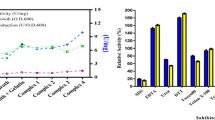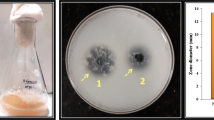Abstract
Extreme halophilic archaea (haloarchaea) have adapted their physiology and biomolecules to thrive in saline environments (>2 M NaCl). Many haloarchaea produce extracellular hydrolases (including proteases) with potential biotechnological applications, which require unusual high salt concentrations to attain their function and maintain their stability. These conditions restrict many of the standard methods used to study these enzymes such as activity determination and/or protein purification. Here, we describe basic protocols to detect and measure extracellular proteolytic activity in haloarchaea including casein hydrolysis on agar plates, quantitative proteolytic activity determination by the azocasein assay and gelatin zymography in presence of the compatible solute glycine-betaine.
Access this chapter
Tax calculation will be finalised at checkout
Purchases are for personal use only
Similar content being viewed by others
References
Oren A (2013) Life at high salt concentrations, intracellular KCl concentrations, and acidic proteomes. Front Microbiol 4:315–321
Paul S, Bag SK, Das S, Harvill ET, Dutta C (2008) Molecular signature of hypersaline adaptation: insights from genome and proteome composition of halophilic prokaryotes. Genome Biol 9:R70
DasSarma S, DasSarma P (2015) Halophiles and their enzymes: negativity put to good use. Curr Opin Microbiol 25:120–126
Souza TACB, Okamoto DN, Ruiz DM, Oliveira LCG, Kondo MY, Tersario ILS, Juliano L, De Castro RE, Gouvea IE, Murakami MT (2012) Correlation between catalysis and tertiary structure arrangement in an archaeal halophilic subtilase. Biochimie 94:798–805
Sinsha R, Khare SK (2014) Protective role of salt in catalysis and maintaining structure of halophilic proteins against denaturation. Front Microbiol 5:165
De Castro RE, Maupin-Furlow JA, Giménez MI, Herrera Seitz MK, Sánchez JJ (2006) Haloarchaeal proteases and proteolytic systems. FEMS Microbiol Rev 30:17–35
Bidle KA, Haramaty L, Baggett N, Nannen J, Bidle KD (2010) Tantalizing evidence for caspase-like protein expression and activity in the cellular stress response of archaea. Environ Microbiol 12:1161–1172
Nercessian D, Di Meglio L, De Castro R, Paggi R (2015) Exploring the multiple biotechnological potential of halophilic microorganisms isolated from two Argentinean salterns. Extremophiles 19:1133–1143
De Castro RE, Ruiz DM, Giménez MI, Paggi RA, Silveyra MX, Maupin-Furlow JA (2008) Gene cloning and heterologous synthesis of a haloalkaliphilic extracellular protease of Natrialba magadii (Nep). Extremophiles 12:677–687
Ruiz DM, Paggi RA, Giménez MI, De Castro RE (2012) Autocatalytic maturation of the Tat-dependent halophilic subtilase NEP produced by the archaeon Natrialba magadii. J Bacteriol 194:3700–3707
Coêlho DF, Saturnino TP, Freitas Fernandes F, Gava Mazzola P, Silveira E, Basile Tambourgi E (2016) Azocasein substrate for determination of proteolytic activity: reexamining a traditional method using bromelain samples. Biomed Res Int 2016:8409183, 6 pages
Giménez MI, Studdert CA, Sánchez JJ, De Castro RE (2000) Extracellular serine protease of Natrialba magadii: purification and biochemical characterization. Extremophiles 4:181–188
Xu Z, Du X, Li T, Gan F, Tang B et al (2011) Functional insight into the C-terminal extension of Halolysin SptA from haloarchaeon Natrinema sp. J7. PLoS One 6:e23562
Zhang Y, Wang M, Du X, Tang W, Zhang L, Li M, Wang J, Tang B, Tang X-F (2014) Chitin accelerates activation of a novel haloarchaeal serine protease that deproteinizes chitin-containing biomass. Appl Environ Microbiol 80:5698–5708
Du X, Li M, Tang W, Zhang Y, Zhang L, Wang L, Li T, Tang B, Tang X-F (2011) Secretion of Tat-dependent halolysin SptA capable of autocatalytic activation and its relation to haloarchaeal growth. Mol Microbiol 96:548–565
Imhoff JF, Rahn T, Künzel S, Keller A, Neulinger SC (2021) Osmotic adaptation and compatible solute biosynthesis of phototrophic bacteria as revealed from genome analyses. Microorganisms 9:46–78
Cadenas Q, Engel PC (1994) Activity staining of halophilic enzymes: substitution of salt with a zwitterion in non-denaturing electrophoresis. Biochem Mol Biol Int 33:785–792
Ibrahim I, Engel PC (2016) Substitution of salt with a zwitterion, betaine, in native-PAGE, SDS-PAGE and affinity chromatography. Malaysian J Biochem Mol Biol 1:11–15
Studdert CA, De Castro RE, Herrera Seitz K, Sánchez JJ (1997) Detection and preliminary characterization of extracellular proteolytic activities of the haloalkaliphilic archaeon Natronococcus occultus. Arch Microbiol 168:532–535
Herrera Seitz MK, Studdert C, Sánchez JJ, De Castro R (1997) Intracellular proteolytic activity of the haloalkaliphilic archaeon Natronococcus occultus. Effect of starvation. J Basic Microbiol 37:313–322
Studdert CA, Herrera Seitz MK, Plasencia Gil MI, Sánchez JJ, De Castro RE (2001) Purification and biochemical characterization of the haloalkaliphilic archaeon Natronococcus occultus extracellular serine protease. J Basic Microbiol 41:375–383
Kirtley ME, Koshland DE Jr (1972) Environmentally sensitive groups attached to proteins. Methods Enzymol 26:578–601
Author information
Authors and Affiliations
Corresponding author
Editor information
Editors and Affiliations
Rights and permissions
Copyright information
© 2022 The Author(s), under exclusive license to Springer Science+Business Media, LLC, part of Springer Nature
About this protocol
Cite this protocol
Paggi, R.A., Giménez, M.I., De Castro, R.E. (2022). Proteolytic Activity Assays in Haloarchaea. In: Ferreira-Cerca, S. (eds) Archaea. Methods in Molecular Biology, vol 2522. Humana, New York, NY. https://doi.org/10.1007/978-1-0716-2445-6_20
Download citation
DOI: https://doi.org/10.1007/978-1-0716-2445-6_20
Published:
Publisher Name: Humana, New York, NY
Print ISBN: 978-1-0716-2444-9
Online ISBN: 978-1-0716-2445-6
eBook Packages: Springer Protocols




